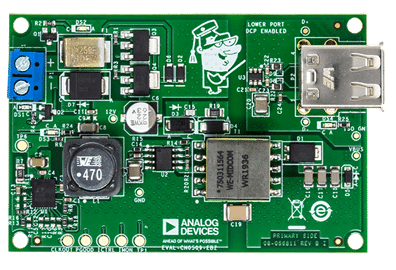- The Dual USB Port Charger can provide a 2 A, 5 V output from various DC power sources.
- The design has a wide input voltage range and two USB charging ports.

During emergency conditions like natural disasters or protracted power outages, locating a power source for charging mobile phones or other Universal Serial Bus (USB) communication devices can be difficult. Although Alternating Current (AC) mains chargers are frequently available, they are useless when no power grid exists. Additionally, when the last USB battery backup charger systems are depleted, it raises the question of alternative methods to charge critical USB-powered devices. Analog Devices (ADI) have launched a reference design for dual USB port charger CN0509 to simplify the design process. The design can supply 2 A at 5 V from various Direct current (DC) power sources and has a wide input voltage range. The circuit features two USB charging ports, one with a dedicated charging port (DCP) controller.
The reference design can transform several DC power sources ranging from 5 V to 100 V into a regulated 5 V, 2 A supply. The design incorporates protection against reverse voltage conditions. The circuit can survive a reverse connection to the DC power source because the polarity of an improvised power supply may be uncertain. The design also includes light-emitting diodes (LEDs) that function as indicators and give visual feedback on whether the power source is connected properly or needs to be changed. The design provides two output ports, allowing for simultaneous use. The design is based on an isolated flyback converter with a step-down (buck) DC-to-DC converter. The reference design includes two LEDs that indicate the input power. An active constant current driver circuit provides steady brightness with slight variance. This circuit maintains the LED current throughout the operating range, offering consistent brightness levels.
The buck converter efficiently converts a greater DC voltage to a lower voltage with little power loss and high power density. A micropower, non-opto, isolated flyback converter follows the buck stage. The converter achieves regulation by indirectly sensing the output voltage through sampling the primary side flyback waveform, eliminating the requirement for optocouplers or a third sense winding on the coupled inductor. The design provides fast charging up to 2A. The design operation remains nearly constant across input voltages ranging from 12 V to 100 V due to the isolated converter’s constant 12 V input. However, it is important to note that lower input voltages reduce available charging current. The dual USB port charger can withstand reverse input connections of up to 100 V. The design can withstand a maximum operating temperature of 150 °C.
ADI have tested this reference design. It comes with a Bill of Material (BOM), schematics, Gerber files, assembly files, Printed circuit board (PCB) layout, etc. You can find additional data about the reference design on the company’s website. To read more about this reference design, click here.





